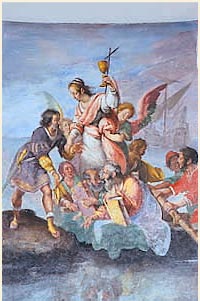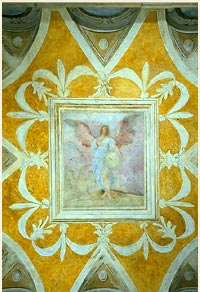Around 1618 Bernardo Strozzi received from Gio. Stefano Doria the task of frescoing a room on the ground floor of Palazzo Branca Doria in piazza San Matteo, unfortunately damaged by humidity and which cannot be seen well any longer. This was the first fresco commission for this painter, who was then taken on to decorate the choir vault in the Genoese church of Saints Tomaso and Domenico, this was destroyed in the XIX century and in whose place the Carlo Felice theatre was later on built. Very little has been preserved of this majestic work of art - a fragment can be found today in the stores of the Accademia Ligustica - the composition is known thanks to a detailed sketch on display in the adjacent museum.
Strozzi's fee was extremely high and only wealthy clients were able to ask him to do work for them: for this reason the very rich Filippo Centurione assigned to this painter the task of the decoration with frescoes of three vaults in the Palazzo Centurione-Carpaneto at Sampierdarena, the best preserved example in the city before the marvellous rediscovery of Strada Nuova.
In 1623 Luigi Centurione (1597-1659) instructed Strozzi to decorate the large staircase, the loggia and on the first state floor, the ceilings in three rooms and two small rooms, in the residence that he had recently purchased in Strada Nuova. Strozzi had to finish the task in eighteen months, but on 24th November 1625, in a document addressed to the Senate of the Republic, Strozzi complains that he had worked more than the agreements made and had not yet been adequately paid.
Centurione did not even let a day pass before replying to this provocation. He accused Strozzi of not having respected the contract "in the time taken, in the work done, and for other reasons": "in the 18 months which started on the 23rd August 1623, he should have painted three rooms in the downstairs apartment and two small rooms and the stairs, up until today he has only painted the vaults in the rooms and has not even started painting the stairs".
A well documented legal dispute was opened, which brought about the sudden interruption of the fresco decorations, thus limited to only the first three rooms: in the two rooms on either side the ceiling decorations were chipped and dulled, by Centurione's orders. While the frescoes in the centrally positioned room were liked by the client and so left as they were.
At the beginning of the eighteenth century, to give more prestige to the second state floor, the Pallavicinis widened the large staircase that linked it with the first floor, to the detriment of previous service accesses, as reconstructed by Poleggi. This intervention implied the building of a new supporting wall that in fact made the central room smaller and fitted with a false ceiling.
Thanks to the intuition of Mary Newcome and Beppe Merlano the frescoes were surprisingly rediscovered: by making a small inspection hole in the vault it was possible to see again what Strozzi painted, extraordinarily well preserved thanks to the reed-matting vault which served as the false ceiling.

Bernardo Strozzi, Main room, detail of the central panel.

Bernardo Strozzi, Astrology room, vault.
